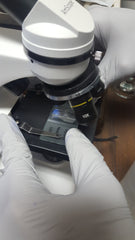Before You Brew, Look For These Things/ Notes On Dust!!!
Plenty can go wrong on brew day. But it's really frustrating to have everything go smoothly and still end up with something that's not as bright and delicious as it should have been. Here are a few tips for ensuring that your wort turns into the most beautiful butterfly it can be (that is if your wort were a caterpillar):
Freshness matters. It matters A LOT. Most of these recommendations stem from that core concept.
YEAST
Yeast has the final say when it comes to your beer, yet it's the ingredient many brewers take most for granted. Though it's only a single cell, yeast is a very complex living organism. If you don't pitch enough healthy yeast into your well-aerated/oxygenated wort, don't expect the best results. Too little healthy yeast can result in any or all of the following: long lag time before fermentation begins, with the worst case scenario being it never starts at all; off-flavors created by stressed yeast cells; greater ester production, often greater than acceptable for balance and style; and underattenuation, meaning higher terminal gravities and sweeter, less quaffable beer.
What do you do? Familiarize yourself with yeast pitching rates and yeast starters. When buying your yeast, check the date. Most liquid yeast will have both a production date and a best by date, whereas most dry yeast only has a best by date. Regardless, fresher is better as you will have more yeast/greater viability. The mrmalty website now has a wonderful yeast pitching calculator that's free to use.
We NEVER intentionally sell out of date yeast. This is unethical. Do not buy out of date yeast; it's a waste of money. If we ever have yeast go out of date, we give it away. You can certainly add some expired yeast to a fresh vial, or make a yeast starter to build the cell count back up.
NOTE: Buy a pack or two of some dry yeast to keep around. If you ever run into a situation where your yeast is old and you're uncertain it'll fully attenuate or the lag is lasting much longer than expected, you have some healthy yeast you can pitch to ensure all doesn't go to waste.
MALTS
Whether you're brewing all-grain, or steeping grains to supplement your malt extract, it's not a bad practice to taste your malt. Unground, most malt will keep fresh for 9-12 months. After that, it will start to stale and lose some of its diastatic power. If the malt tastes really stale or spongy, the stale flavors will carry over to the final beer. Consider using a different malt.
Malt extracts, especially liquid ones, will also stale and oxidize, which is why you won't get the true color and flavor of the malt as if you'd brewed all-grain (dry malt oxidizes less, so it is a truer profile). You can check the bottom of the can for production dates. If it's more than 9-12 months old, consider a different malt or a different brew store.
NOTE: Darker grains contain more antioxidants, so they are more stable over time than base malts or lighter character malts. This holds true for darker malt extracts as well.
WATER
Water is the canvas upon which you paint your beer.... or something. Start with good quality water. If your water is exceptionally hard or contains lots of iron, consider buying spring water or reverse osmosis. If your water contains chlorine, do the same or run it through a charcoal filter first. You can also treat your water with campden tablets to knock out the chlorine---use at a rate of a 1/4 tablet per 20 gallons of water. When yeast metabolizes chlorine, it spits out some unpleasant harsh compounds into your beer.
If you brew all-grain, the importance of water cannot be stressed enough. Get to know your water either through send-off tests such as Ward Labs, buy a home water testing kit (specific to brewing), or start with a blank slate such as RO water and build the profile from there. The Brewers Association book, Water, by John Palmer is excellent if you want to delve deeply into the water chemistry rabbit hole.
HOPS
This one is a little trickier since you can't typically smell hops at the store. I always smell the hops prior to adding them to the boil. For me, it's as much about learning the characteristic of the hop and enjoying the aroma as it is ensuring freshness. As a general rule (and this doesn't always hold true...as in the case of Medusa hops which honestly don't smell great until the final beer), if your hops smell bad, they're going to be bad.
Old hops might smell cheesy and, if used, will impart a cheesy or sweaty gym sock aroma to the beer---not pleasant. This is because as the hops age, the alpha acids degrade. Humulone, specifically, contains isovaleryl which, with age and oxidation, unbinds itself from the molecule and will become a flavor-active compound.
That cheesiness is isolvaleric acid, which is a short-chain fatty acid commonly found in cheese and foot odor. I'm going to guess that you don't want to be serving your guests a Sweaty Foot Stout... Use fresh hops, and if sourcing in bulk, use them as quickly as possible. In the meantime, vacuum seal them and keep them in the freezer to retard the rate of degradation.
NOTE: It doesn't hurt to have an extra ounce or two of hops on hand just in case you get a surprise on brew day and one of your hop additions smells terrible. If brew day goes smoothly, simply use your reserves soon, on the next beer perhaps, and snag another backup at the shop.
DUST
Yes, our shop is dusty. Counter-intuitively, more dust means more business, which means faster turn over of ingredients. Grain produces insane amounts of dust. Watch us weigh out a grain bill some time and you'll see the plumes of fine dust wafting out. When we refill grain bins---dust clouds. When we mill grain---so much dust. Soooo much dust.
So while it doesn't look as nice, we are very proud and thankful for our dust, and you should be too. As I said, it means fast turnover.
WHAT WE DO FOR YOU
As alluded to with the whole dust equals fresh paragraph above, we keep busy. On top of that, though, we don't stockpile hoards of ingredients. We bring in two-three pallets every week and order yeast as needed (usually that's weekly). With this fast turnover, we can ensure that your ingredients are not hanging around on the shelf very long and they're as fresh as they can possibly be. Don't believe us? Put us to the test using the notes above. Don't shop with us? Employ these discretionary observations wherever you do shop; it can make the difference between beer that's drinkable and beer that's enjoyable.
Cheers!!!
Tedd
- Tags: homebrew homebrewing ingredients tips
- Theodore Clevenger


Comments 0